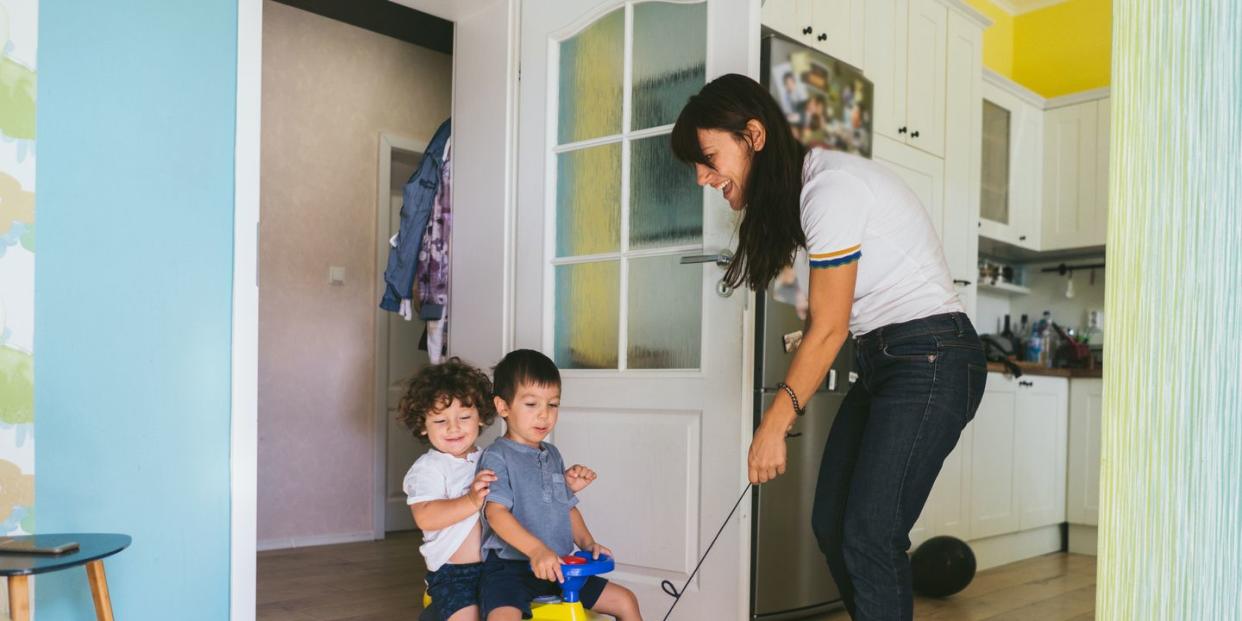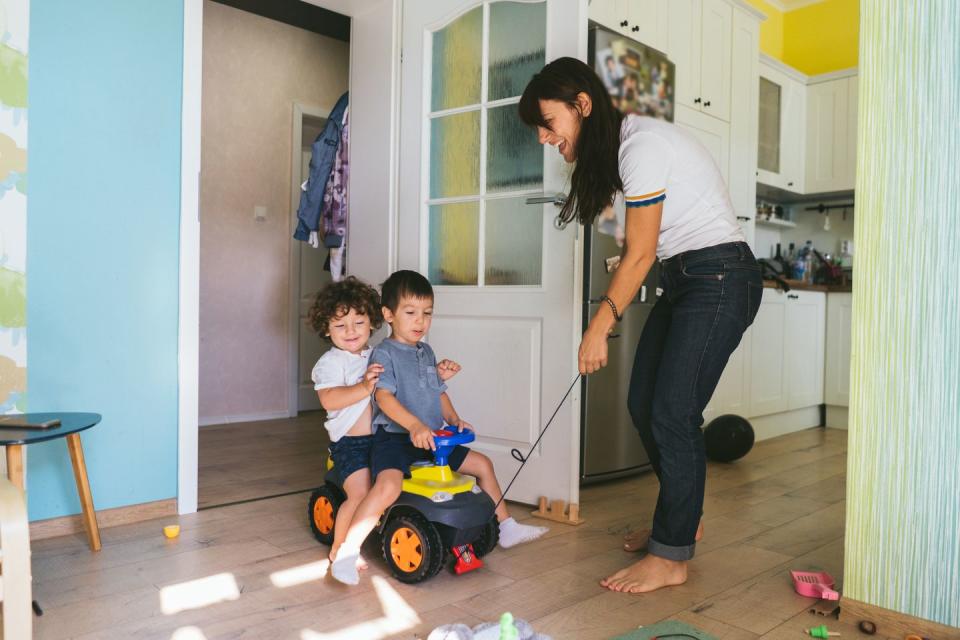Got Kids? You Need a Pitch-In Parent


Growing up, Cora Neil did not daydream about being married with babies. It was never her vision.
“The fact that I’m married is surprising to me,” says the landscape designer and owner of a small plant shop in Cypress Park, Los Angeles.
Neil lives with her husband in a house they also share with their two dogs, cat, and pair of hamsters. The youngest of five kids, she was an aunt by age 6. She’d never had any interest in being a mother, but she’d always sensed deep in her heart she’d make a good caregiver.
Until about 10 years ago, only 5 percent of adults didn’t want to have children of their own. Now it’s closer to 50 percent. And it’s no wonder. Parents were already burned out before the pandemic, but now they have even more to worry about: soaring housing, inflation, the premature expiration of the Child Tax Credit, Covid-related school closures or sick days they can’t take off from work, a scarcity of affordable daycare. The parenthood bust is attributable to a variety of factors. The primary reason given in a 2021 Pew Research pole was “they just don’t want to have children,” followed by medical reasons, financial reasons, and a lack of partner. Pew’s vague “just don’t want to” category could cover more precise, systemic concerns on people’s minds, like climate change and economic instability. Raising a child is hard. What if one, or even two people, just isn’t enough to raise a family?
To say parents could use a little more support is a gross understatement. But don’t think it’s only grandparents or licensed childcare professionals who are qualified caregivers. For adults like Neil, who aren’t parents but play an active role in kids’ lives, showing up and helping is not an obligation but an opportunity to connect with people they care about.
Before lockdown, she and husband Matt Smith had formed a very close bond with the kids next door, getting happily roped into baking pies and projecting outdoor movies with school-age Mars and Desi; in fact, the four of them had been chatting over the fence for a year before the couple officially met the kids’ parents.
“It was like the neighbor from Home Improvement, where you can only see the tops of people’s heads over the fence,” she says, referring to the ’90s sitcom. Neil is sad the family moved away—the parents split up—but she jokes she’s asked about her “visitation rights” as an auntie.
Lucky for her, her friends have kids, too. When they land at Neil’s house, they pile out of their car and dash straight to the toy bin, where they rummage for books and craft supplies to noodle with. Sometimes they’ll grab a tool and dig around in the dirt, or harvest carrots and berries as Neil, also a landscape designer, gets on her hands and knees and teaches them about gardening. They harvest carrots and berries from her garden and learn from Neil about how to grow stuff. Being an auntie brings her so much joy, she says, but she doesn’t take the job lightly: She keeps a toy bin but importantly also a filing cabinet with copies of legal documents, in case anything happens to the kids or their parents.
“I always knew I was a nurturing person,” she says. “I just didn’t think it had to be reserved for my own children.”
News has traveled about Neil’s extra duties. She adds wryly, “Now people have finally stopped asking my husband and me when we’re going to have a child.”
That’s a question climate scientist Krista Jaspers’s mother knows better than to ask her. Jaspers has never wanted any children of her own and is happy raising her three dogs. But at her Honolulu home, kids traipse in and out with the kind of breeziness she says is typical of Hawaii. She leaves her door unlocked and her pantry full of snacks for her young neighbors children.
“I’m the one adult at the party to jump into the pool with the kids,” she says with an endearing mix of embarrassment and pride.
Jasper has become particularly close to four kids, ages 6 to 10, who live nearby, and she’s also close to her best friend’s kids, ages 5 and 7, who live five minutes away. When parents need help and dial “Auntie Krista,” as she’s called by the kids, she’ll come right over, sometimes staying for hours. She gets the children ready for baths, washes their hair, reads, and snuggles them into bed. She’s so reliable as a caregiver that she’s been asked to pick up a kid from school when they were sick.
Having the responsibility of an aunt, including being on call in case of an emergency, is the perfect alternative to the commitment of parenting, says Jaspers: “I get the whole experience without having to give up my freedom.”
Parents could use more informal support like this, especially in the U.S., where they struggle from a woeful lack of social safety nets like paid family leave or universal childcare (or universal healthcare; the list could go on). And when parents do get it, it makes a huge difference.
“These connections really do provide additional support,” says Dawn Dow, associate professor of sociology at the University of Maryland. “These networks matter to our psychic and social health.”
The nuclear family often gets idealized, Dow says, but it’s a historical outlier. Even in the ’50s and ’60s, an era that might typically evoke for you a mom and a dad and two kids in the suburbs, there were a variety of other family models. For example, Dow notes, extended-kin and fictive-kin networks have always been the norm for Black households, in which it is more common to ask your longtime neighbor or childhood best friend to help raise your kid with you. Some of these nurturing networks have their origins in painful histories—another part of the long story of the American family.
Today, having learned a hard lesson during the pandemic, families from all different backgrounds are embracing these networks. But some of these changes may already have been underway. The number of people living in multigenerational family households has quadrupled since 1971, for reasons both practical and emotional. And even when we don’t live with them, we live close to them, relatively. According to a New York Times analysis of academic data, the average adult lives only 18 miles from their mother. “The data reveal a country of close-knit families, with members of multiple generations leaning on one another for financial and practical support,” the Times reports.
However, not everybody has family they can rely on. While there’s research on the rates of multigenerational living, there’s hardly anything on fictive-kin networks, or social support from people who aren’t related to you. In fact, scholars wonder why this information is so difficult to source.
As Dow says, “We’re not designed to be islands. We’re not supposed to be alone.” Many adults might be opting out of parenthood, but they could be opting in as life rafts
Erin Sagen is a freelance journalist based in Seattle who covers parenting, health, and culture. Her work has appeared at The Washington Post, NBC News THINK, Slate, Parents, and more. You can follow her on Twitter @erin_sagen.
You Might Also Like

